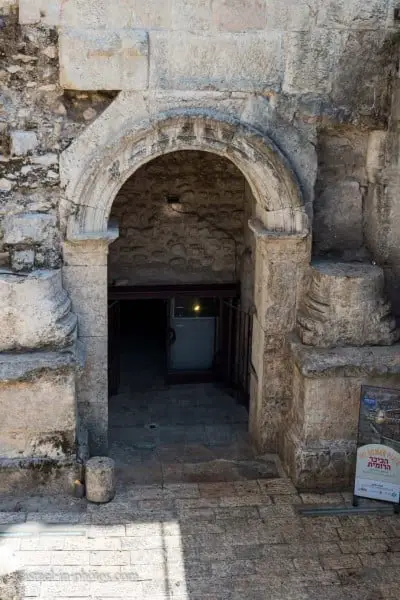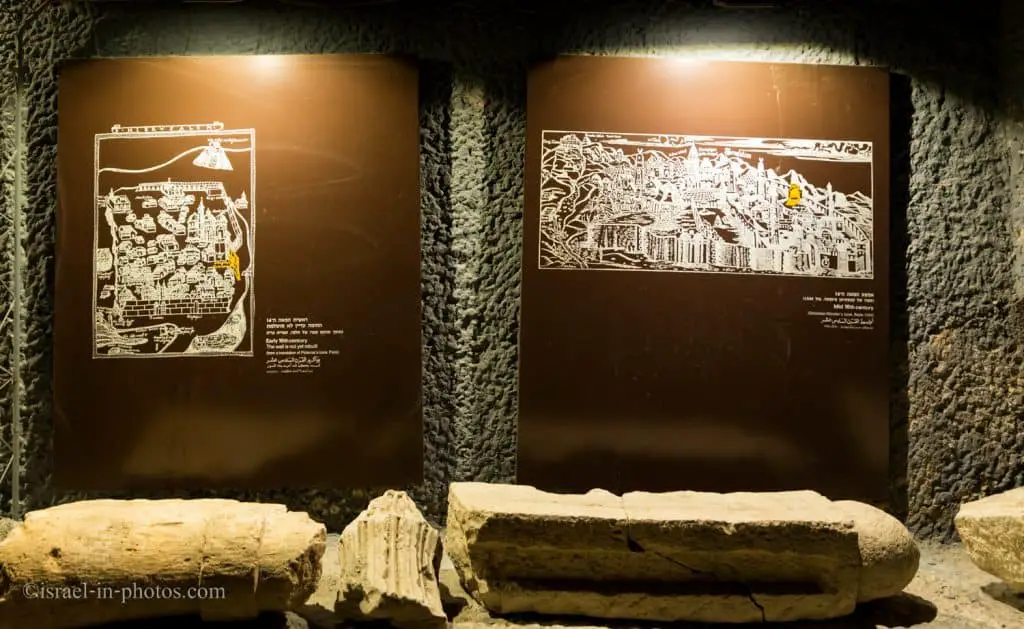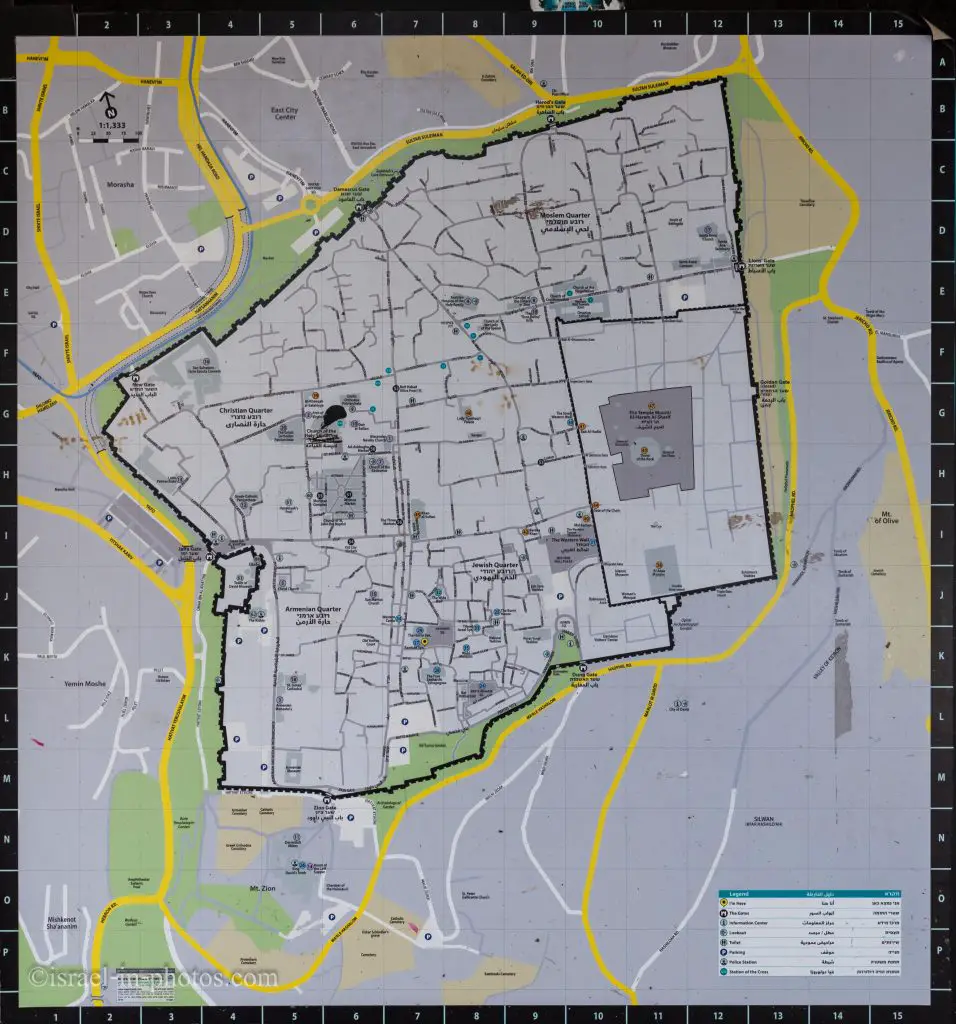The Roman Plaza, Jerusalem – Visitors Guide
The Roman Plaza is a small museum that shows findings from the Roman period. And it is located below Damascus Gate in the Old City.
Table of Contents
Map
The entrance to the Roman Plaza is located about 20 meters to the east of Damascus Gate. It is also near Zedekiah’s Cave.
Directions for drivers: Link to Waze and Link to Google Maps
Directions for public transport: Link to Moovit
Interactive map of the area:
You can find the following map in several places in the Old City of Jerusalem.
Note: You can click on the map to enlarge it.
On the map above, the Damascus Gate is in square D6.
In the following photo, you can see Damascus Gate to the right and entry to The Roman Plaza to the left.

Directions
Different alternatives (bus, light train, car) are available to reach the Old City. And you can find detailed info at the Old City of Jerusalem.
Opening Hours
Note: The Roman Square is closed until further notice. You can find additional info on the official site.
Sunday – Thursday and Saturday: 09:00 – 17:00 (till 16:00 in winter and till 19:00 in June, July, and August).
Friday – closed.
Entrance Fee
Regular entry – 10 NIS
The Roman Plaza and Ramparts Walk – 20 NIS

History
Roman period – Emperor Hadrian (135 C.E.)
Construction of the gate, towers, and staircases. The hall serves as a guard room.
Byzantine period (centuries: 5 – 6)
The gate is made narrower, and the tower is divided into two floors.
Early Arabic period (centuries: 7 – 8)
The staircase is converted into a water cistern. An oil press is installed on the lower floor of the hall.
Fatimide – Crusaders period (centuries: 9 – 13)
The oil press is not in use. Its parts are used for building benches along the walls.
Mameluke period (centuries: 13 – 15)
The hall and gate are filled with earth and stones.
Ottoman period (centuries: 16)
Construction of the existing gate and the present ceiling in the Roman hall.
East Jerusalem Development Ltd. unearthed the Roman gate and staircase in 1981.
Source: sign

And here is a short video telling about this place:
Damascus Gate
To reach the Roman Plaza, we need to take the stairs down beneath Damascus Gate. And the location of Damascus Gate is not coincidental. Here is some info:
The well-known, present-day Damascus Gate is one of the major gates in the Old City walls of Jerusalem, built in the 16th century by the initiative of the Ottoman ruler, Sultan Suleiman the Magnificent.
Damascus gate was built along the lines of a classical Roman city gate, a triumphal arch flanked by two sturdy watch towers. The central entrance was built in the center of the gate, on the plan of a monumental arch. On either side was a side entrance, also arched. Tall columns stood on either side of each entry, making four columns across the width of the entire gate. A triangular pediment was built above the gate. On either side of the gate were towers containing guardrooms with staircases linking the ground floor to the top of the tower.
The lower part of the tower on the left of the gate has survived in its original state. Outside one can see the large, finely dressed stones. Inside, the tower has been preserved to a considerable height, including the stairs, which are open to visitors.
The lower part of the tower was used in the Arab period as an olive press.
Source: sign

The Roman Gate
The Roman Gate was built in the days of Emperor Adrianus, with the establishment of Colonia Aelia Capitolina in Jerusalem (in 135 CE). At the time, a tall pillar was built in the square, from which the distances between Jerusalem and other cities were measured.
The gate had three portals: one large central one, situated beneath the opening of today’s Damascus Gate. And two smaller decorated openings flanking it. Of the three portals, only the eastern one remains complete. The corridor beyond it leads to the interior of the east gate’s tower, one of two towers found on either side of the gate. The tower has been preserved at its full height (12 meters), and only its ceiling is a later addition. The staircase that leads to the top of the tower was preserved in its original form, and today it leads to the Wall Walk.
Source: sign

And now, let’s enter the museum.
Madaba Map
A photo Madaba Map is the first thing you can see when entering the museum.
The Madaba Map is part of a floor mosaic from the early Byzantine church of Saint George in Madaba, Jordan. And on that mosaic map, you can see Jerusalem. Moreover, Jerusalem is depicted with its northern Roman gate.

Aelia Capitolina
With the conquest of Jerusalem by Titus in 70 CE, the city was destroyed, and its walls were razed to the ground. In 130 CE, Emperor Hadrian visited Judea. He decided to establish in Jerusalem the colony of Aelia Capitolina (named after the Emperor’s family, Aelia-Aelius, and the three Capitoline gods, Jupiter, Juno, and Minerva). It is unclear whether the city was built before the Bar-Kokhba Revolt (132 CE) or following it (after 135 CE).
Aelia Capitolina was planned anew, exhibiting a sophisticated road network leading to important destinations in four directions. During this period, the gates were set as monumental architectural elements, devoid of a city wall, indicating the initial and terminal points of the principal roads. With the departure of the Tenth Legion from Jerusalem (289 CE) and its redeployment in Eila (Eilat) and the lax security in the entire region, a wall was erected and linked to the already existing gates.
Below the foundations of the Ottoman Damascus Gate were found the remains of a free-standing city gate situated on Jerusalem’s northern boundary, dating to the time of the Roman city of Aelia Capitolina. As the northern gate was one of the Roman city’s four major portals, its architectural design and decor were quite elaborate.
In the Madaba Map, dating from the 6th century BCE, Jerusalem is depicted with its northern Roman gate, which continued in use during the Byzantine period. A gate stood here also during the Crusader period, and it was well-fortified by an anterior gate.
Source: sign


Besides the Madaba Map, you can find a small museum dedicated to Damascus Gate.



In the early 16th century, the wall was still not finished (left exhibit). And in the middle of the 16th century, it was completed (the right drawing).



As mentioned above, you can purchase a combo ticket to The Roman Plaza and Ramparts Walk. You can follow the signs to the eastern guard tower if you do.



Summary
If you love history and archeology and have visited Jerusalem many times before, I recommend visiting The Roman Plaza. Also, it is not a big place, and a typical visit will take 0.5 – 1 hour. Therefore, combine your visit with other nearby places (see the interactive map at the top for ideas).
Have you been to The Roman Plaza? Tell us about your experience in the comments below.
That’s all for today, and I’ll see you in future travels!
Stay Tuned!
For additional points of interest nearby, check out Jerusalem.
Additional Resources
Here are several resources that I created to help travelers:- Trip Planner with Attractions and Itineraries is the page that will help you create your perfect travel route.
- What is the Best Time to visit Israel? To answer this question, we will consider the weather, prices, holidays, festivals, and more.
- Information and Tips for Tourists to Israel will answer the most common questions tourists have about Israel (including safety, passports, weather, currency, tipping, electricity, and much more).
- Israel National Parks and Nature Reserves include a complete list, top ten, map, tickets (Israel Pass, Matmon, combo), and campsites.
- If you are looking for things to do, here are the pages for Jerusalem, Tel Aviv, Haifa, Sea Of Galilee, Akko (Acre), Eilat, Nazareth, Safed (Tzfat), and Makhtesh Ramon.








